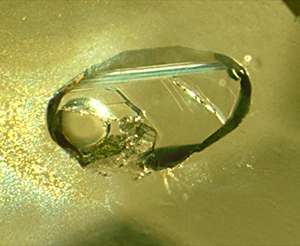Inclusions are among the most important features for identifying ruby and sapphire. This is the chapter on ruby and sapphire inclusions from Richard Hughes' 1997 book, Ruby & Sapphire.
Note: The following is only one chapter of Richard Hughes' 1997 book, Ruby & Sapphire. If you like what you see, order a copy of the revised 2017 edition direct from the publisher.
To see the world in a grain of sand, and heaven in a wild flower; hold infinity in the palm of your hand, and eternity in an hour. William Blake, Auguries of Innocence. Stanza 1
Under the Magnifying Glass • Ruby & Sapphire Inclusions
One of the most fascinating and rewarding aspects of gemology is the study of inclusions. These tiny bits of entrapped foreign debris or structural irregularities reveal much about the gems in which they lie entombed. Often regarded as flaws, which detract from a stone's value, they are actually valuable clues that help unravel the secrets of a gem's past. Not only do inclusions speak to us of the place of formation, but they also serve as hallmarks of the processes which gave rise to precious stones. Flaws? Hardly. Without them the creations of nature would be almost indistinguishable from what Eduard Gübelin (1973) has so aptly termed "the usurpers from the factory."
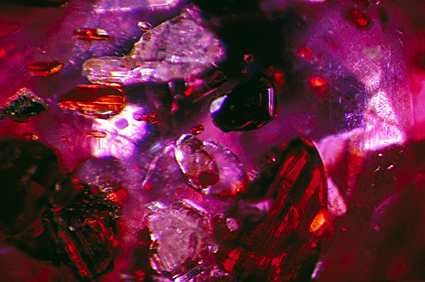 Figure 1. Crystals of rutile, sphalerite and calcite explode from the depths of a Mogok ruby. 50x. (Photo: John Koivula)
Figure 1. Crystals of rutile, sphalerite and calcite explode from the depths of a Mogok ruby. 50x. (Photo: John Koivula)
History of inclusion research
While the study of gemstone inclusions has expanded greatly in the twentieth century, scientists have been peering into crystals for centuries. The great Roman polymath, Pliny, in his first-century AD encyclopedia, stated: "Further, one sees in false carbunculi certain small inclusions, that is blisters and vesicules, which look like silver." (Ball, 1950). This is doubtless a reference to the gas bubbles of glass. Al-Biruni, the 11th century Central Asian scholar, specifically mentioned inclusions in yakut, the Arabic word for corundum:
Among the blemishes of the ruby which Al-Kindi has mentioned is the inner strain which, if too conspicuous and deep, cannot be removed. The other is the khalt-i-hijarah (admixture of stones) which is called hurmulliyat. Hurmal (harmal or white rue) is white. In Persian it is called kunjdah. Another blemish is that of rim, i.e., a kind of dross that is like earth. Still another is that of a perforation which detracts from its clarity and transparency. This appears in the form of a crack which results from the collision of a vitreous object which something and the crack is so wide that water may pass through it. It is physical as well as temporary. Variegation in colour, e.g., greater in one part and less in the other, is counted as a defect. Cloudiness also deducts from the value of the stone. A pearl-like stain may be present on the stone on any part. This blemish is known as asin. If not deep, it would disappear on rubbing [polishing?] the stone. There is no other way in which to do away with this defect, as it is rather deep.
al-Biruni, ca. 11th century (Biruni, 1989)
One can immediately read into the above, color zoning, included solids, healed fractures (fingerprints) and silk inclusions.
With the invention of the microscope in the 17th century, it became possible for the first time to examine the interior of gems up close. But the modern era of inclusion research did not really begin until the 1820s, with the papers of Davy (1822), Brewster (1826, 1827), Sorby (1858), Sorby & Butler (1869), and Lea (1869a–b, 1876). These works accurately described fluid inclusions, including those of two and three-phases, as well the silk inclusions so common in corundums.
In the modern era, no one has had a greater influence on inclusion research than Eduard Gübelin. While his first book on inclusions was published in 1953, he is largely known for his 1973 masterpiece, The Internal World of Gemstones. Here Gübelin combined the observational talents of a master scientist, with the aesthetic sensitivity of an artist and William Blake-like prose. It is one of those rare works which instantly transcends, and transforms, the field. Such was, and is, the influence of this work that no one who has seen this book ever looks at, or describes, the interior of a gemstone in the same way. While it has been superseded by Gübelin's, Koivula's and other's later works, it has not been topped. The Internal World of Gemstones remains a gemological tour de force.
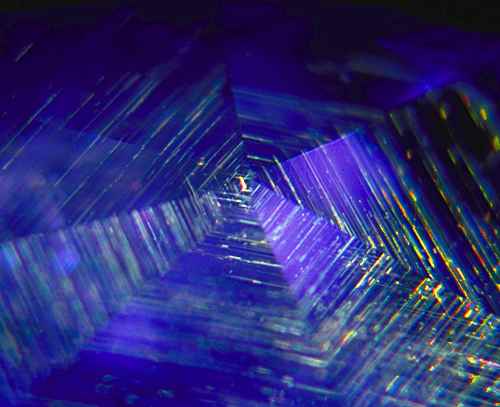 Figure 2. A rutile silk spider’s web spun beneath the facets of an untreated Sri Lankan sapphire. (Photo: R.W. Hughes)
Figure 2. A rutile silk spider’s web spun beneath the facets of an untreated Sri Lankan sapphire. (Photo: R.W. Hughes)
The microscope – A gemologist's best friend
To view inclusions, a microscope is required. In terms of optics, look for a stereo-zoom head with a magnification range from 10–60x (this can be increased with stronger eyepieces and/or a doubling objective lens). Surprisingly enough, quality of optics is not nearly so important as the microscope base. Many so-called gemological microscopes are lacking in one important area – lighting. Without proper illumination, one sees nothing, even with the best optics. Thus a microscope must possess an extremely strong, built-in light source (a 35-watt quartz halogen bulb is the absolute minimum). GIA/Gem Instruments' Gemolite base is one of the best available for all-round use. Even better is that designed by Marc Bogerd and the author for the Asian Institute of Gemological Sciences. The Gemolite is greatly improved by modification. Dump the 35-watt bulb and move up to a more powerful model. Use of a bulb with a vertical filament (as opposed to horizontal) produces a wider band of effective illumination. While the stronger bulb may create problems for heat-sensitive gems, it is worth the risk. Once again, if the specimen is not adequately illuminated, you see nothing.
The humble stoneholder is another oft-overlooked aspect of microscope design. A poor-quality stoneholder inevitably results in the "jewelers' prayer meeting" – down on your knees praying to find a stone that has flown out of sight. Surprisingly, many stone holders lack a knurled groove on the inside to grasp the stone's girdle. The best used by the author was that made by GIA/Gem Instruments; however it is no longer made.1
|
David Brewster – Pioneer of inclusion research Art. XXIV . – Notice respecting the existence of the New Fluid in a large cavity in a specimen of Sapphire. By David Brewster, LL. D. F. R. S. and Sec. R. S. Edin. In two papers which are printed in this Journal, I have fully described the physical properties of the two new fluids which occur in mineral bodies. These fluids having been found only in the precious stones, – in quartz, amethyst, topaz, and chrysoberyl, it became interesting to detect them in other minerals, not only with the view of establishing their general prevalence at the formation of this class of bodies, but of ascertaining if they experienced any change in their properties from the mineral in which they are found. Mr Sanderson lately put into my hands a specimen of sapphire, containing a very large fluid cavity, which, from the expansible nature of the fluid, seemed to resemble that which occurs in topaz. The cavity itself is regularly crystallized, and is about one-third of an inch in length. The fluid occupies about two-thirds of its length, and fills the cavity at a temperature of 82° of Fahrenheit. It seems to be more viscid and more dense than I have usually observed it, and in consequence of this property, the capillary margin of the fluid remains distinct and well marked, even at the instant when it fills the cavity. When the temperature descends below 82°, the contraction of the fluid is not accompanied with that violent effervescence which takes place in the deep cavities in topaz. In the specimen under consideration, the fluid seems to have exerted a high expansive force upon the sides of the cavity, which it has succeeded in opening on both sides. The surfaces of the fissures thus occasioned, are covered with specks of a gelatinous-looking matter, like portions of the second fluid, when in a state of induration. The force, however, was not sufficient to burst the specimen, and the only effect of it seems to have been to expel into the fissures the second fluid, which always occupies the angular and narrow parts of the cavity. This opinion seems to be confirmed by the fact, that none of the second fluid can be seen within the cavity, although this may arise from the difficulty of examining the angular portions of the cavity in the present state of the specimen. There is another very interesting peculiarity in this specimen of sapphire. It contains at one extremity of the fluid cavity distinct groupes of transparent crystals, which have, no doubt, been deposited by the fluid. What these crystals are, we are not entitled to conjecture, but if the cavity were opened, it might be practicable to ascertain whether or not they are sapphire. David Brewster, 1827, Edinburgh Journal of Science |
Mastering the microscope – Illumination techniques
Dark field
The mainstay of the gem microscope, dark-field illumination brings light from the sides (via a reflector), thus silhouetting inclusions on a dark background. It is good for viewing a variety of solid and fluid inclusions, as well as narrow growth lines. Handheld fiber-optic lights can also be used to provide dark-field illumination. In many respects, they are superior to the built-in dark-field microscope lighting.
One of the keys to successful use of the microscope is mastering the various illumination techniques. Below are shown many of the important lighting methods for gemstones. (Modified from Koivula, 1981)
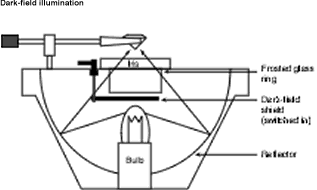
Figure 3.
Light field (transmitted light)
Good for locating broad areas of color zoning, as well as checking inclusion transparency. If the iris diaphragm is narrowed to an aperture slightly less than the diameter of the gem, this is also useful for seeing into heavily included gems.
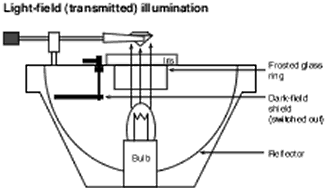
Figure 4.
Diffuse light field (white filter)
Diffuse light-field illumination is achieved by placing a frosted white plastic or glass filter over the microscope. It is useful for locating broad growth zoning, and is even better with the addition of an immersion cell and appropriate liquid. Surface-diffusion treated corundums are readily detected by this method.
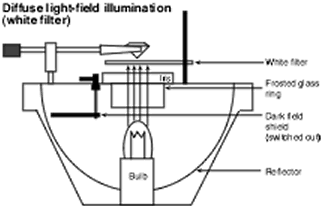
Figure 5.
Diffuse light-field (blue filter)
With yellow and orange sapphires, a special need arises. Many microscopes have light sources with a yellowish tint. When combined with the yellowish color of the di-iodomethane immersion fluid, it is no wonder that curved color banding in synthetic yellow/orange sapphires is difficult to see. Addition of a frosted blue filter counteracts the yellow color of the light and liquid, allowing the growth features of yellow and orange stones to be seen more readily (Hughes, 1988; see Figure 7).
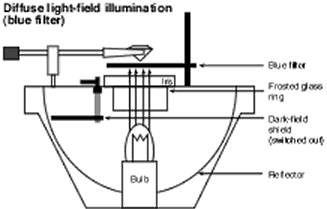
Figure 6.
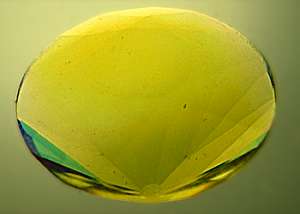
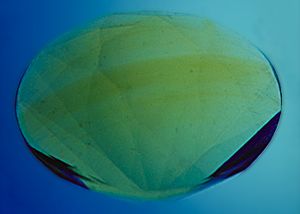 Figure 7. The power of the blue filter technique can be clearly seen in the above photos. With normal lighting (white filter), little is visible. But with a frosted blue filter, the curved color banding in this Verneuil synthetic yellow sapphire is clearly visible. (Photos by the author)
Figure 7. The power of the blue filter technique can be clearly seen in the above photos. With normal lighting (white filter), little is visible. But with a frosted blue filter, the curved color banding in this Verneuil synthetic yellow sapphire is clearly visible. (Photos by the author)
Overhead lighting
When surface features are to be examined (either on the stone or on the inclusion itself), overhead lighting is needed. This is obtained either by a built-in overhead light or by using the handheld fiber-optic light. Generally the fiber-optic light works best. Examination of inclusion surfaces can provide valuable clues as to their identity.
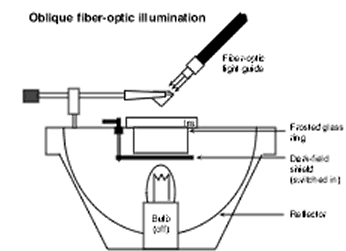
Figure 8.
Immersion
Due to a gem's shape, it is often difficult to see its interior clearly. Immersion in a liquid of similar RI (di-iodomethane for corundum) greatly reduces surface reflections. Horizontal immersion microscopes, which allow one to examine the specimen while remaining seated, are popular in Germany. Vertical models are common in the USA. I prefer the vertical models, because manipulation of the stone is far easier and quicker (to change the gem's position in the stoneholder, it is simply placed on the bottom of the cell and picked up in a different position). When looking for subtle features, such as curved growth zoning in synthetic yellow sapphires, one hour or more may be required. The difficulty of specimen manipulation with horizontal microscopes increases examination times by a factor of five to ten. To overcome the comfort problem of using a vertical microscope for immersion, it is best to place it on a low platform, so that one can remain seated while examining the specimen (Hughes, 1989, 1990).
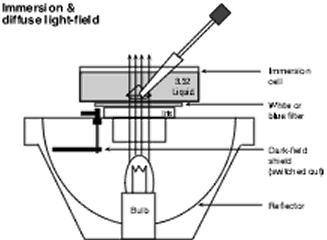
Figure 9.
Crossed polars
Examining a gem between crossed polars is the best way to locate the presence of twinning and structural strain. Immersion may also be used together with this method. Twinning planes will appear as bright planes against a dark background as the gem is rotated. Plato twinning in Verneuil synthetic corundum is seen by viewing the gem parallel to the optic axis while immersed between crossed polars. Crossed polars are also useful for separating solid crystals from negative crystals (solid crystals may display a different extinction from the host, if they are birefringent).
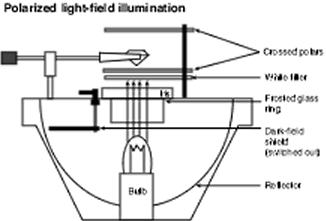
Figure 10.
Light field shadowing
John Koivula (1982b) has described a lighting technique which he has dubbed shadowing. Shadowing involves opening the microscope to normal light field and passing the edge of an object (such as a business card) between the stone and light. If done properly, detail is enhanced in a narrow part of the stone. This is useful for resolving the fine detail of narrow growth lines, especially those in natural corundum and the curved striae of Verneuil and Czochralski synthetic rubies. Ideally the edge of the business card should run parallel to the growth lines. Another method is to narrow the microscope's iris diaphragm to a size just less than the stone's diameter.
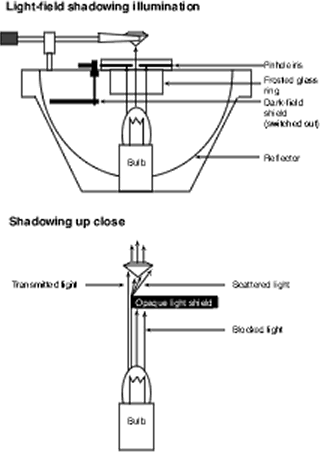 Figure 11. Subtle growth features, such as extremely fine zoning, are often brought out via shadowing. Shadowing is effected by using transmitted light, and slowly bringing an opaque object, such as the edge of a business card, between the light and gem. (Modified from Koivula, 1982b)
Figure 11. Subtle growth features, such as extremely fine zoning, are often brought out via shadowing. Shadowing is effected by using transmitted light, and slowly bringing an opaque object, such as the edge of a business card, between the light and gem. (Modified from Koivula, 1982b)
|
Tips on proper microscope use The most important instrument available to gemologists is the microscope. But just having a microscope does not a gemologist make. You must know how to use it. The following will help you get the maximum out of your microscope. Rule 1 – Clean and adjust the eyepiecesBefore you put the stone in the stoneholder, check the eyepieces to ensure they are both clean and properly focused. Like all lenses, eyepieces need periodic cleaning. This should be done with special lens cleaning fluid and lens tissue. Always blow on the lens before using the fluid and tissue, so as to remove any dust particles that might scratch the glass. Then apply a drop of fluid to the tissue and gently clean the eyepiece with a circular motion. But the best cure is prevention. Cover your microscope when not in use. This will ensure that it stays in top condition. If well-cared for, a microscope can last a lifetime. Eyepieces must also be properly focused. If your eyes are both exactly the same (in terms of focus and strength), the eyepieces should be at the same height. A scale is provided on one eyepiece to show the adjustment position. The zero position is correct for people whose eyes are identical. If vision in one eye is different than the other, you will need to adjust the eyepieces. To focus the eyepieces, do the following:
Rule 2 – Clean the stoneSuch a simple task, but too often ignored. The single most important microscope skill is cleaning the stone before examination. No matter how often hands are washed, some oil remains. Touching the stone applies fingerprints, but not the kind we like to see. Cleaning is best accomplished with a clean piece of cotton cloth. Cotton has the ability to absorb skin oils, while simultaneously removing dust. Other types of cloth will unfortunately leave either the dust, or grease, behind. This includes most fancy polishing cloths (such as those used for cleaning eyeglasses and the leather cloths for cleaning jewelry). Dipping the gem in alcohol also works. After the gem is clean, don't touch it again. Pick the stone up directly off the cotton cloth with the stoneholder. Remember, every time a stone is touched, a little oil and dust adhere to it. Rule No. 3 – Examine the stone from all possible directions while varying the lighting conditionsA gemologist's life would be far easier if gems were cut as parallel-sided plates. But they're not. Facets are designed to reflect light back to the viewer, not transmit it. This means light entering the stone from behind (transmitted light) will typically not pass straight through. If we want to see inclusions, we must constantly change the light paths through the stone. This is done by changing the position of the stone relative to the light and changing the light relative to the gem. Change the position of the gem relative to the light: The stone must be examined from all possible directions. This is crucial. Locating inclusions has little to do with visual acuity. When the stone is properly positioned, almost anyone can see the inclusion. The difference between expert and novice is that the expert constantly changes the stone's position relative to the light source. So even if you're not an expert, act like one. Check the stone from all possible angles by constantly moving the stoneholder and shifting the position of the gem in the stoneholder. Change the light relative to the gem: It is not only important to keep shifting the gem's position in the stoneholder, but also to vary the lighting conditions as you do so. Gemological microscopes differ from those used in other fields because specimens are not viewed between two pieces of flat glass. Faceted gems have surfaces that stick out at odd angles; hence the light must enter at odd angles. This is why the lighting setup is so important to a gemological microscope. A good microscope will allow a variety of lighting possibilities (see the following section). Learn to use them. Rule No. 4 – Use a fiber-optic lightThe fiber-optic light source is generally the best for occasions which call for either dark-field or overhead illumination. It allows one to view inclusions that were invisible a mere 15 years ago (before the advent of fiber-optic lighting).Fiber-optic lighting has two main advantages. First, it is both intense and concentrated. In many stones, resolution of inclusion data depends on how much light can be brought to bear on a tiny part of a tiny inclusion. A fan-cooled 150 watt quartz halogen bulb behind a good fiber-optic light guide is tough to beat. Second, the light is mobile – you can move it where it is needed most. |
Inclusion types & formation
What is an inclusion?
John Koivula (1991) has provided us with probably the best definition of the word inclusion:
Broadly defined, an inclusion is any irregularity observable in a gem – by the unaided eye or [using] some tool such as a hand lens or microscope. The 'irregularity' may be a substance, such as a solid mineral crystal or a fluid filling a cavity, or it may be an unfilled cavity, a fracture, or a growth pattern that produces some optical effect.
Inclusions in gemstones can be classified according to the scheme proposed by Gübelin (1973) and Gübelin & Koivula (1986), which is based upon their age with respect to that of the host crystal. This is as follows:
Pre-existing inclusions (protogenetic)
Inclusions that have formed before the host. These are strictly of a solid nature (pre-existing liquids and gases don't count).
A collection of corundum inclusions from the brush of master photographer, John Koivula |
|
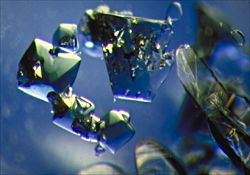 |
 |
|
Figure 12. |
|
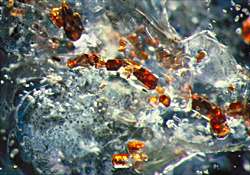 |
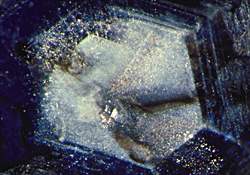 |
| Figure 13. Middle left: Primary rutile crystals (orange) in a sapphire from Rock Creek, Montana; 25x. Middle right Secondary, exsolved rutile "silk" clouds in a sapphire from Rock Creek, Montana; 20x. |
|
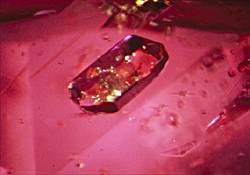 |
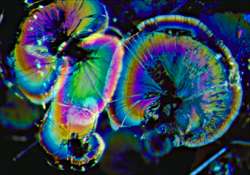 |
| Figure 14. Lower left: Light yellow apatite crystals in a corundum from Umba Valley, Tanzania; 25x. Lower right: Discoid fractures caused by heat treatment in an Australian sapphire; 45x. (Photos: John Koivula) |
|
Solid and semi-solid inclusions
Crystals and/or glasses that form before the host and are subsequently trapped. The crystals may appear either as heavily etched or corroded individuals which formed long before the host, or as well-formed crystals which developed just prior to the host
Examples:
Various, including spinel in ruby. Corundums which formed in metamorphic environments, such as Burmese rubies, are often rich in solid inclusions.
Contemporary inclusions (syngenetic)
Inclusions that have formed at the same time as the host.
Solid and semi-solid inclusions
Crystals and/or glasses that form, and are trapped, at the same time as the host. It is usually impossible to tell from a microscopic examination whether or not a solid inclusion formed before the host.
Examples:
Various, including calcite and dolomite in ruby from metamorphic environments (such as Mogok, Burma).
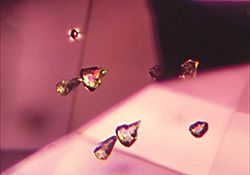 Figure 15. Solid inclusions in a Sri Lankan sapphire, viewed between crossed polars. Note the strain and interference colors on the crystals. (Photo by the author)
Figure 15. Solid inclusions in a Sri Lankan sapphire, viewed between crossed polars. Note the strain and interference colors on the crystals. (Photo by the author)
Primary cavities
These consist of cavities formed while the host itself was growing. When they display some semblance of crystal shape, they are termed negative crystals. They may be trapped for a variety of reasons (see Figure 17), most commonly due to rapid growth. When a crystal grows rapidly, it no longer grows with smooth, flat faces, but instead grows with faces that have channels.2 Such channels provide perfect pockets for trapping of the growth solution. Primary cavities may be filled with liquid alone (single phase), liquid + gas or liquid + solid (two-phase), or liquid + gas + solid (three-phase). At times, the gas bubble of a primary cavity may move. Edwin Roedder (1962) described it thus:
When the bubble is small enough to respond to statistical irregularities in the number of molecules striking it, and is free of the inclusion walls, it can be seen to wander continuously in a jerky Brownian movement. It is fascinating to watch such a bubble under the microscope and to think that it has been nervously pacing its cell for perhaps a billion years.
Figure 16. Two views of a primary negative crystal in a Sri Lankan sapphire. The cavity contains liquid and gaseous CO2, along with a mobile graphite crystal cluster. In the top photo, a CO2 bubble is clearly visible, while in the lower photo the CO2 bubble has disappeared from the gentle heat of the microscope. The black graphite crystals can also be seen to have moved in the lower photo. (Photos: John Koivula; 35x)
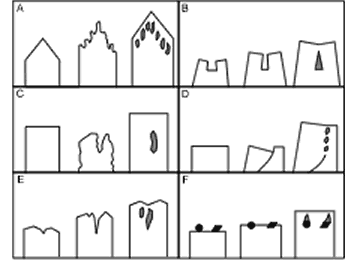 Figure 17. Trapping mechanisms of primary fluid inclusions A. Rapid feathery growth is covered by later solid growth. B. Subparallel growth traps fluids. C. Dislocation etched out during partial dissolution is later covered by new growth. D. Disturbed growth near a fracture in the surface of a growing crystal results in trapping of primary fluid inclusions. E. Primary fluid inclusions are trapped between or at the centers of growth spirals. F. Enclosure of any foreign object on the surface of a growing crystal may include some of the growth fluid as well. (After Roedder, 1984)
Figure 17. Trapping mechanisms of primary fluid inclusions A. Rapid feathery growth is covered by later solid growth. B. Subparallel growth traps fluids. C. Dislocation etched out during partial dissolution is later covered by new growth. D. Disturbed growth near a fracture in the surface of a growing crystal results in trapping of primary fluid inclusions. E. Primary fluid inclusions are trapped between or at the centers of growth spirals. F. Enclosure of any foreign object on the surface of a growing crystal may include some of the growth fluid as well. (After Roedder, 1984)
According to Roedder (1982), crystals which have grown from metamorphic environments tend to be relatively deficient in primary fluid inclusions. Instead of growing as free crystals, protruding into the fluid from which they grew, crystals in metamorphic rocks have grown in an essentially solid medium by migration of the nutrients via diffusion through other crystals, along grain boundaries, or through a fluid film in the grain boundaries. Space for the growth is found by the dissolution or shoving aside of adjoining crystals. As a result, crystals formed in metamorphic rocks often contain many solid inclusions, but few, if any, fluid inclusions.
Primary cavities generally result where certain areas of the host have grown more rapidly than others, forming, and eventually enclosing, voids. Flat crystal faces, once facing outward, now enclose hollow spaces, and may look just like solid crystals. These voids usually contain a liquid and/or gas bubble trapped at the time of their enclosure. Other solids may also be enclosed (or crystallize later from the trapped fluid). Scientists study such trapped fluids, for they provide important clues regarding the conditions under which the gem formed, being remnants of the original growth solution.
Negative crystals can often be recognized by identical crystal orientation to the host, along with their high relief, due to the liquid or gas filling. More substantial evidence is provided by the gas bubble sometimes trapped within the liquid. It is always delightful to observe a bubble which bobs up and down as the crystal is tilted in the microscope. Such mobile bubbles are quite common in minerals like quartz and fluorite, but less so in corundum (except from Sri Lanka and Madagascar). Heat treatment will often cause explosion of such negative crystals (Koivula, 1980a; 1986).
Examples. Primary cavities are common in all minerals, especially in gems which grow from solution environments, such as quartz, fluorite, beryl, and corundum.
 |
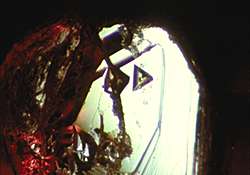 |
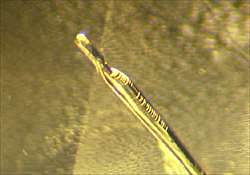
Figure 18. |
|
Primary growth phenomena
-
Primary twinning – Twins that formed at the same time as the host ('growth twins'). These typically occur as single planes only, rather than being repeated throughout the crystal.
Examples: Spinel and diamond macles (twinned octahedra), penetration growth twinning in Sri Lankan and Kashmir sapphire, etc. -
Growth zoning – During a crystal's growth, coloring agents may not be available in consistent amounts. The result is a layered appearance of lighter and darker lines (or bands) which follow the external surfaces of the crystal. This is similar to the growth rings of trees, except that with single crystals, the external surfaces are flat and meet at specific angles. Thus the growth lines of single crystals will always be straight (never curved, unless one looks in directions not parallel to the faces along which they formed). They may form parallel to any of the faces that are, or were, present while the crystal was growing.
The external surfaces of synthetic single crystals grown by the Verneuil, Czochralski and floating zone processes are not flat, and so the growth lines are not straight. Synthetic gems grown by the flux and hydrothermal processes possess flat faces, and so will display straight growth lines meeting at the face angles.
 |
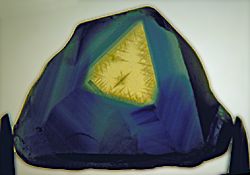 |
|
Figure 19. Angular growth zoning in sapphires from Australia. Such zoning may be found parallel to any of the crystal faces. It is never curved if viewed exactly parallel to the crystal face along which it formed. (Photos by the author) |
|
Secondary inclusions (epigenetic)
Inclusions that have formed immediately, or even millions of years, after the host stopped growing.
Solid inclusions
Exsolved crystals – Exsolution is the "unmixing" of a solid solution. At high temperatures, crystals have more defects, and thus are better able to absorb impurities. As the crystal cools, defects are reduced. This may force impurities to crystallize out. But because of the constraints placed on their movement by the solid host, impurity atoms are unable to travel large distances. Therefore, rather than forming large crystals, they migrate short distances to form multitudes of tiny needles, plates and particles, along the directions in the host where space permits.
One of the keys to recognizing exsolved inclusions is that they always form in a specific pattern within the host. That pattern may be different for different minerals crystallizing within the same host material (for example, rutile is exsolved in corundum in three directions crossing at 60/120° in the basal plane). Virtually all tiny, oriented needle, particle and platelike inclusions found in minerals are formed via exsolution. These inclusions give rise to asterism and cat's eye phenomena. Examples: rutile and hematite-ilmenite silk and needles in corundum.
One of the most diagnostic features of corundum is the white clouds of exsolved rutile (TiO2 ). According to Gübelin (1940, 1953), Gustav von Tschermak (1878) was the first to identify rutile in corundum. Such clouds vary from dense concentrations which follow, and distort, the crystals' color zoning, to thinly-woven tapestries. At times, only slender threads or particles are visible, while in other cases knife or dart shapes appear (see Figure 21). Closer examination reveals many of these to be twin crystals with tiny v-shaped re-entrant angles visible at the broad end. They are flattened so thin in the basal plane that, when illuminated with a fiber-optic light guide from above, bursts of iridescent colors are seen, due to the interference of light from these microscopically-thin mineral lances.
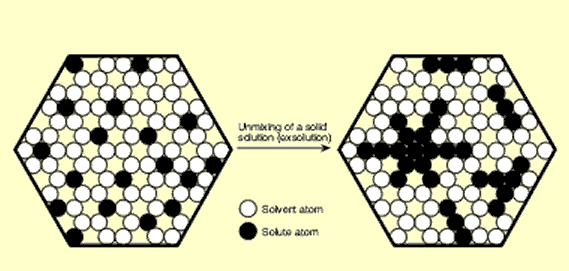 Figure 20. Exaggerated and simplified atomic view of exsolution in corundum During exsolution, solute atoms migrate together to form their own crystals within the host. The orientation of these crystals is governed by the host structure. As a result, they are exsolved in a specific pattern. Within corundum, rutile (TiO2) unmixes in the basal plane, parallel to the faces of the second-order hexagonal prism {1120}, while hematite (Fe2O3) or ilmenite (FeTiO3 ) exsolves parallel to the first-order prism {1010}; boehmite (gamma -AlO·OH) exsolves along the rhombohedron {1011}
Figure 20. Exaggerated and simplified atomic view of exsolution in corundum During exsolution, solute atoms migrate together to form their own crystals within the host. The orientation of these crystals is governed by the host structure. As a result, they are exsolved in a specific pattern. Within corundum, rutile (TiO2) unmixes in the basal plane, parallel to the faces of the second-order hexagonal prism {1120}, while hematite (Fe2O3) or ilmenite (FeTiO3 ) exsolves parallel to the first-order prism {1010}; boehmite (gamma -AlO·OH) exsolves along the rhombohedron {1011}
The needle clouds just described are termed silk, in analogy to their threadlike pattern and are responsible for the asterism, or star effect. Not only rutile may form silk in corundum; hematite (Fe2O3), ilmenite (FeTiO3) or hematite-ilmenite mixtures have been reported. Rutile in corundum tends to unmix parallel to the faces of the second-order hexagonal prism {1120}, intersecting in three directions at 60/120° in the basal plane (Sahama, 1982). Hematite-ilmenite exsolves in the basal plane parallel to the first-order hexagonal prism {1010} (Moon & Phillips, 1984). Thus when both rutile and hematite-ilmenite are present in the same crystal, a 12-rayed star is possible.
 |
 |
| Figure 21. Rutile silk in corundum Left: Exsolved rutile "silk" in a Burmese sapphire, viewed parallel to the c axis; 45x. Right: A magnified view of the silk at left. Note the arrow shapes of the rutile silk. Such perfectly formed silk is proof that a specimen has not been subjected to high-temperature heat treatment. (Photos by the author, using oblique fiber-optic illumination) |
|
Another exsolved inclusion in corundum is boehmite. Consisting of hydrous aluminum oxide (gamma AlO·OH), it is produced in corundum by alteration at stress points along the edges of the rhombohedron faces. This occurs along a total of three directions (meeting at 86.1/93.9°), but only two directions occur in the same plane. These planes lie at approximately 30/60° to the c axis.
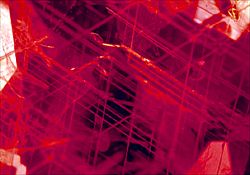 |
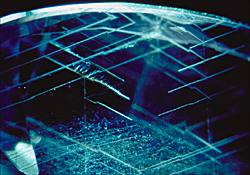 |
| Figure 22. Boehmite needles in corundum (above left and right) are commonly confused with rutile silk, but are easily separated by their orientation. Exsolved boehmite unmixes in three directions parallel to the edges of the rhombohedron (three directions total, but only two in the same plane. The needles intersect at 86.1/93.9°. Boehmite needles are typically found at the junctions of crossing twin planes. (Photos by the author) | |
Secondary cavities
These are healed fractures. Any time after the host has grown it may crack. If the conditions are right, growth solutions may enter the crack and dissolve its walls. Dissolved nutrient material is later re-deposited on the walls of the crack, causing it to "heal" shut.
Some cracks have healed more than others, but most cracks are in some stage of healing. Healing leaves behind tiny pockets of growth solution which has exhausted its nutrients, and so stopped healing. All that is needed for healing to continue is for the gem to be heated up enough so that the trapped solvent can further dissolve the walls of the cavities. Then the healing continues.
As healing progresses, pockets of trapped solvent become smaller and more regular in shape. Eventually, a healed crack has the appearance of tiny crystals scattered in a "fingerprint" or "feather" pattern. The individual cavities may be filled with a liquid alone, liquid + gas, liquid + solid, or liquid + gas + solid, and may usually be differentiated from primary fluid inclusions by their tiny cavities, curved outlines and fingerprint-like patterns. In contrast, primary negative crystals tend to occur singly, and in larger sizes (Eppler, 1966).
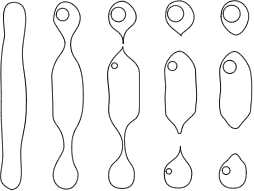 Figure 23. The "necking down" of a fluid inclusion with time from its original state (left to right). Each stage occurs at a higher temperature than the one before it. (After Roedder, 1962)
Figure 23. The "necking down" of a fluid inclusion with time from its original state (left to right). Each stage occurs at a higher temperature than the one before it. (After Roedder, 1962)
Fractures may develop for a number of reasons, including simple shock, or more likely, from the buildup of strain due to rapid growth or tectonic forces. Immediately, or even millions of years later, the healing process can begin. Should cracks develop as a crystal is growing, the growth solutions penetrate the open wound via capillary action. If the temperature of the surrounding environment is high, healing progresses rapidly; at lower temperatures the pace is slower. The inner walls of the curving fracture are dissolved and solutions redeposit this material, as well as any nutrients carried in by the solution itself, forming flat crystal faces. Slowly, inexorably so, the crack is sealed, leaving behind pockets of undigested fluid in fanciful designs termed fingerprints, feathers, insect wings, etc.
Should the conditions be favorable, this ongoing process of solution and re-deposition of internal fracture walls eventually results in highly angular pockets of fluid, actually groups of fluid-filled negative crystals arranged in a fingerprint pattern (Roedder, 1962). Experiments performed by Eppler (1966) and others on different minerals, including Verneuil synthetic ruby, have confirmed the above reconstruction of events leading to the formation of healing fissures and negative crystals in gemstones.
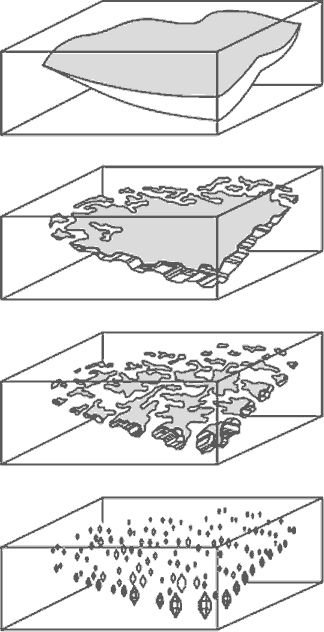 |
Figure 24. The healing of a crack in a crystal, resulting in secondary cavities ('fingerprint'). A. A fracture develops during or after the crystal's growth. B. Healing begins. Growth solutions flow into the fracture and/or the inner walls of the crack are partially dissolved, beginning the healing process. C. Healing continues. Dissolved nutrients are re-deposited on the inner walls of the crack as the healing proceeds. D. Eventually the fluid-filled cavities become more angular in shape, turning into fluid-filled negative crystals arranged in a fingerprint pattern. The fluid that remains behind has been leeched of its nutrients. These pockets containing exhausted growth solutions are smaller along the inner edges and bigger near the outer edges of the original crack. (After Roedder, 1962) |
In nature, the healing process may take place over millions of years. Thus the resulting cavities are often well developed and display intricate growth features. In corundum, when the fracture was in or near the basal plane, the pockets of undigested fluid often surround hexagonal "islands" of healed material. But if the fracture is along a prism face, such healed islands tend to be rectangular (see Figure 25).
Tiny growth steps or "terraces" provide further evidence of the amazing regularity of crystallization processes. In many cases, the residual fluid is so thin that brilliant interference colors are seen when illuminated at the proper angle from above (fiber-optic lighting provides an excellent illumination source for such observations). Although flux-grown synthetic corundums may contain flux-filled inclusions formed by a similar healing process, the tremendous detail of nature is missing, because of greater flux viscosity and the far shorter growth times. Thus, the gemologist should carefully study the healing fissures in natural rubies and sapphires under high magnification. They can provide important clues in distinguishing between natural and synthetic corundum.
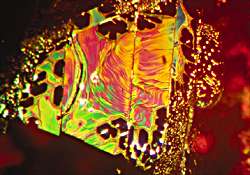 |
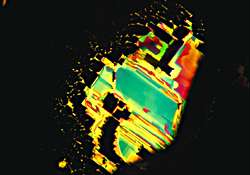 |
| Figure 25. Secondary fluid inclusions (healed fractures, or 'fingerprints') often display the symmetry of the underlying crystal structure in the healed areas. Left: A healed fracture in a Thai ruby which formed parallel to the basal pinacoid. As the c axis (3-fold symmetry) runs perpendicular to this face, the healed (dark) areas display distorted hexagonal or triangular (60/120° ) outlines. Vertical lines cutting through the fingerprint are repeated twinning striations. Right: A fingerprint in a Sri Lankan sapphire. Here the fingerprint has formed parallel to the c axis, and so the healed (dark) areas show rectangular (90° ) outlines, indicating the two-fold symmetry at right angles to the c axis. (Photos by the author using oblique fiber-optic lighting) |
|
Secondary growth phenomena
Secondary Twinning – Twinning that has formed after the host. When such twinning occurs repeatedly throughout the crystal, it is termed "polysynthetic twinning."
- Transformation twins – At high temperatures, a crystal may be untwinned, but as it cools the resulting strain causes the crystal to be "transformed" into a repeatedly twinned crystal. This is common in the plagioclase feldspars, such as labradorite.
- Slip or glide twins – If certain types of crystals are subjected to mechanical stress or pressure at any time after their formation, the bonds between planes of atoms may be broken and the planes "slip" or "glide" across one another into a twinned position, with new bonds immediately formed (if the pressure is too great, however, the crystal just breaks). This type of twinning often occurs repeatedly throughout a crystal, and due to the pressure that produced it, such crystals often contain many cracks (as well as healed cracks). Examples: Rhombohedral twinning in corundum, quartz (amethyst) and calcite.
Within corundum, polysynthetic twinning occurs parallel to the faces of the rhombohedron {1011}, which intersect each other at angles of 86.1 and 93.9° and meet the c axis at 32.4/57.6°. Repeated twinning in corundum is easily observed under the microscope. The planes are only visible when looking exactly along them, and generally pass across the entire stone (although not always). Since polysynthetic twinning takes place on the rhombohedron faces, it is located by looking in directions at about 33/57° to the c axis. Most natural corundums are cut with the c axis perpendicular to the table facet; in such stones the rhombohedral twinning will be found lying about 33/57° off the table. Immersing a gem in di-iodomethane and examining it between crossed polars allows the twinning to be located most quickly, as it appears as bright planes fringed with interference colors against a dark background. It can be a stunning visual effect (see Figure 26, top).
A final note on inclusion categories
Gems often display inclusions involving combinations of the above categories. For example, so-called "Saturn" inclusions of Thai/Cambodian rubies are actually solid crystals which, when they cooled, created tension resulting in a healed fracture surrounding the crystal. While the host/inclusion age relationship will sometimes be obvious (such as inclusions produced by exsolution, which are always epigenetic), many times it is impossible to determine. So don't worry if you cannot determine a particular inclusion's age relationship to the host.
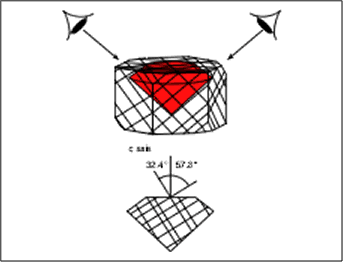 |
 |
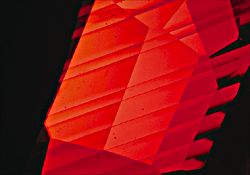 |
|
| Figure 26. Repeated twinning in corundum Left: Repeated twinning in natural corundum generally occurs parallel to the faces of the rhombohedron {1011}, which intersect the c axis at 32.4/57.6¡. As most natural rubies and sapphires are cut with the c axis at 90¡ to the table facet, this means that the twinning will usually be found at about 33/57¡ to the table. Boehmite needles, which form parallel to edges of the same face (at the junctions of twinning planes), will thus be found in the same directions. They run in three directions (but only two in the same plane) and meet at angles of 86.1/93.9¡. Repeated twinning is located most easily between crossed polars with the specimen immersed in di-iodomethane. When seen, such twinning planes often do not penetrate across the entire stone. Top: Polysynthetic twinning on the rhombohedron {1011} in a Thai/Cambodian ruby, viewed between crossed polars. (Photo by the author; 30x) Bottom: Polysynthetic twinning on the rhombohedron {1011} in a Thai/Cambodian ruby, viewed under dark-field illumination. (Photo by the author) |
|
Identifying solid inclusions
Unfortunately, most publications do not mention exactly how the identity of a solid inclusion was determined. The following are common techniques (based on Hänni, 1987):
X-ray powder diffraction method
A small amount of powdered material from a solid inclusion is required. If the inclusion is not exposed at the surface, the specimen is ground to expose it. Using a diamond file or point, the inclusion is scraped to gather material, which is then powdered and used for a powder-diffraction x-ray photo. The resulting diffraction pattern is compared to known samples for identification.
Electron beam methods
When a solid inclusion is exposed at the surface, the scanning electron microscope (SEM) coupled to the electron microprobe (EMP) can be used. A fine beam of electrons is directed onto the inclusion surface. This generates x-rays which are typical in terms of energy or wavelength for each element present. Emitted radiation (fluorescence) can be analyzed using an energy-dispersive system (EDS) attached to the SEM or EMP, with the resulting energy spectrum allowing one to make a qualitative determination of the chemical composition. The SEM has the advantage of being able to strongly magnify the analyzed area and produce pictures of the surface, while the EMP is used primarily for full quantitative chemical analysis. Both techniques are nondestructive, but suffer from an inability to detect the lightest elements.
Raman-laser probe
Solid, liquid or gaseous inclusions can be analyzed with this technique. A monochromatic laser beam is focused on the inclusion, and, via interaction with oscillating molecules, undergoes a frequency change characteristic of the material excited. The resulting spectra, recorded in the infrared region, are compared to reference spectra for known solid, liquid and gaseous phases. Of the methods discussed, the Raman technique is the least-commonly used in gemology.
Optical methods
Inclusions are typically identified by their appearance under the microscope (crystal habit, color, relief, luster, orientation, etc.). This has the advantage of simplicity, but depends entirely on the tester's experience. Only a microscope is needed and inclusions need not be exposed at the surface, but, of all the methods described, it is the least reliable. Unfortunately, for the vast majority of gemologists, it is the only method to which they have access, but by carefully describing the inclusion many problems can be mitigated.
Table 1: Inclusions of corundum |
||||||||||||||
|
Table 2. Describing inclusions: Complete and incomplete examples |
||||||||||
|
Overview of corundum inclusions
See Table 1 for a summary of the possible inclusions in corundum. For details and references on the individual occurrences of these inclusions, see the country listings in Chapter 12.
Country descriptions of inclusions
In Chapter 12, the inclusions of corundums are described for each major source, alphabetically by country. It must be stressed that it is often impossible to determine the age of a given inclusion with respect to the host. For this reason, only the type, position and appearance have been described.
The author has not personally collected and tested samples from each and every mine (the only sure way of determining origin). Thus, the descriptions are based on the best-available data, first and secondhand, at the time of writing. The descriptions are in no way sufficient for determining the origin of corundums, and even if they were, origin reports in their current form are not something I feel gemologists should be doing. Suffice to say that, similar to humans, all of the corundums to which I have spoken claim planet earth as their home. It may be of academic and historical interest to know where someone comes from, and so it is for gems. But an origin determination of an individual gem without reference to its quality is as senseless as applying ethnic generalizations to individual humans.3
An additional fly in the origin ointment is that heat treatment often obscures origin information. This may be a blessing in disguise, for it could push the trade into concentrating their efforts on separating natural from treated and synthetic stones, rather than worrying about geographic origin. In this area, the colored stone trade has much to learn from the diamond business. After all, how many customers ask for, say, a Botswana diamond?
Notes
1. The current model is a wire type. While it works well for diamond grading, it is inferior to the old type because it lacks the knurling. [ return to chapter text ]
2. Classic examples of such rapid growth are the dendritic patterns of snowflakes. [ return to chapter text ]
3. Because a variety of qualities are found at every source, origin reports divorced from a quality appraisal are meaningless, and open the door to abuse by unscrupulous sellers. [ return to chapter text ]



